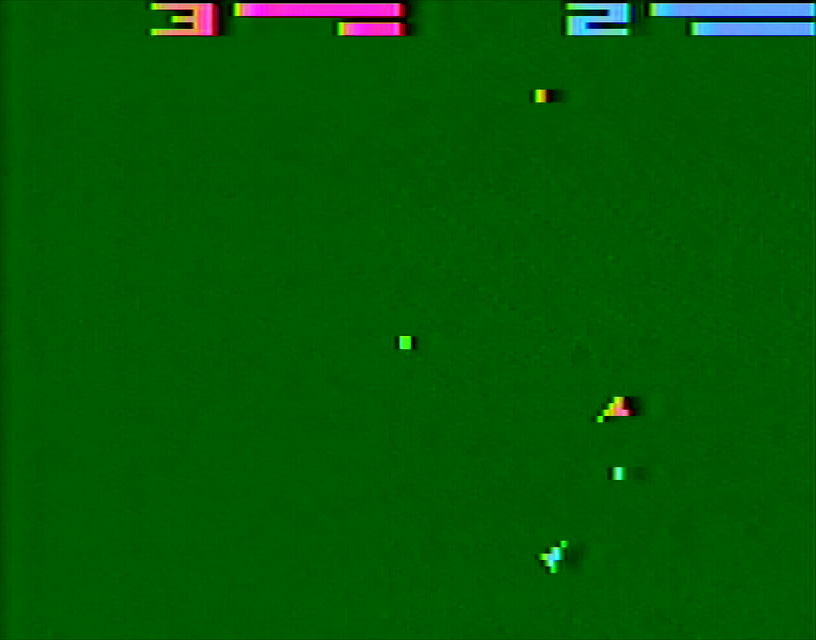
Fresh off a strong and successful 1977, Atari’s Video Computer System was in a good place. Hundreds of thousands of units had been sold; the company’s home game design team continued to grow and was getting more experienced. Having exhausted most of Atari’s top-tier arcade titles, those same developers had to get creative on what to make next. One of those designers, Ian Shepherd, seemed to have decided to look backwards for inspiration – about 15 years backwards, specifically, to one of the very first video games ever designed: Spacewar.
For the unfamiliar, Spacewar is a two-player space combat game where each player controls a ship on opposite ends of the playfield. In between the two is typically a star pulling them in with its gravitational field; each player only has a limited amount of fuel and ammunition to maneuver around and destroy their opponent. As a result, it’s generally not worth trying to break free from the star’s hold, but rather using its gravity to your benefit as you move around the screen, sparingly using your fuel supply to adjust your course. In case you’re drifting right into an enemy torpedo or the star itself, most versions of the game also include some kind of hyperspace jump, allowing the player a risky chance to escape a deadly situation.
Among the most influential video games ever developed, Spacewar was initially designed in the early months of 1962 in what can best be described as a team effort. Describing the history of the original Spacewar is an article all by itself (and has been several times, which I’ll link in the sources), but we can hit on the major aspects here. In late 1961, the Digital Equipment Corporation gave the Massachusetts Institute of Technology, or MIT, a PDP-1 computer system, which was one of the most advanced computers 1961 had to offer. This was not the first computer at MIT, as the university already had other machines such as the TX-0, but the newfound power of the PDP, along with the display that arrived at the university at the end of 1961, allowed for new research and experimental possibilities. Jumping back a bit to early 1961, three computer hackers named Steve Russell, Martin Graetz and Wayne Wiitanen, who each had some connection either working at MIT (Russell, Wiitanen) or having gone to school there (Graetz, Wiitanen again), were all working at Harvard in its statistical computer lab before Graetz got a job working for MIT professor Jack Dennis. Dennis was a computer guy going back to the Whirlwind mainframe who essentially controlled access to the TX-0, and as all of them shared an interest in computers and model railroads, he encouraged them to mess around with it after hours. This led to the development of a variety of demos and experimental programs from the trio alongside other early hackers like Alan Kotok, Dan Edwards, Robert Saunders and Peter Samson. Anticipating the PDP-1’s arrival in the fall, that summer Graetz, Russell and Wiitanen started brainstorming what they could do to push the machine to its limits, and being fans of pulpy science fiction like the Lensman book series and the Buck Rogers comics, they came up with the idea of a space-themed demo program that was entertaining to play and watch, that would have enough player interaction to be different every run, and would also use all the resources the PDP-1 had available to it.
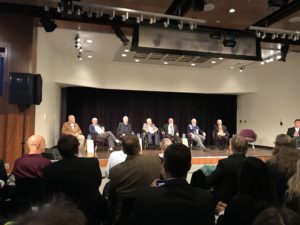
Of course, brainstorming is one thing and actually writing the game is another. Wayne Wiitanen had been called up as an Army reservist by the fall and Martin Graetz was in a different department at MIT at the time, leaving Steve Russell, who had been talking a big game with the other hackers who hung out at MIT, as the person most able to implement their idea. Russell continually put it off as 1961 started to close out, culminating in his claim that he didn’t know how to write a sine-cosine routine. This finally prompted Alan Kotok to head out to Maynard, Massachusetts to DEC headquarters to get copies of a sine-cosine routine for the PDP-1, presenting them to Russell with a group of onlookers asking what his excuse was now. Russell, now embarrassed, set about actually writing the program. Russell finished an initial version at some point in January or early February (as the PDP-1’s display didn’t arrive until December 29, 1961) that was very barebones – little more than the two player ships, some fuel and some torpedoes. In the 2018 Spacewar Reunion at the Smithsonian Museum of American History, Russell notes that other folks felt they could improve upon his program, which he welcomed. Dan Edwards figured out how to speed up the display program with a “just-in-time” compiler, and what’s more, Edwards felt that the ornamental star in the center of the screen could become a gameplay element by implementing a gravity routine that would pull the player ships towards the star. Peter Samson, annoyed with the random starfield (and recognizing that players need some background element to view their ships against), created the “Expensive Planetarium,” a rendition of the real-world night sky as seen from between the 22nd parallels up to the fifth magnitude. A version of the game was shown off in late April at MIT’s Parents Weekend Open House and was a huge hit. Russell revisited the game in September to create a version 3.1 that had some code tweaks and adjustments to the visuals and to the hyperspace mechanics before taking a job at Stanford University, bringing a version of the game with him. A further version 4.1 came along by the end of the year, when the PDP-1 received upgrades that allowed the gravity code to be more precise. The original Spacewar “crew” drifted off in their careers, leaving the game to be carried on by new generations of students and staff. Spacewar proved popular enough at MIT that it was banned from play during business hours, but it was about to spread out.
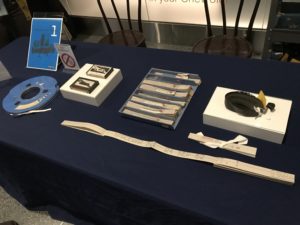
Since the game was both open-source, used all of the PDP-1’s processing capabilities, and was created at MIT, the Digital Equipment Corporation (which had strong ties to the university) started using it as a test and demo program to highlight the power of the PDP-1. Of course, very few units capable of running the game existed in the world at the time even after it was publicized in DEC’s User Society newsletter and conferences. There were a couple hotspots such as the University of Minnesota (where an MIT alumni developed a conversion for the CDC 3100) and at defense contractor Bolt, Beranek and Newman. But Russell’s copy coming to the Stanford AI Laboratory proved to be a catalyst for the game’s hottest spot outside of Boston. Over the years programmers at these hotspots and anywhere else folks could get the game running (on PDPs, the Data General Nova or even the LINC minicomputer) began to tweak the game for their own liking. Some variants included removing the sun in favor of a black hole, replacing the random hyperspace jump with a cloaking device, adding a visual flair to a hyperspace jump, or even just changing simple variables like the strength of gravity, how many shots could be fired at once or how much fuel each ship has. Due to the game’s rather high hardware requirements for the time, Spacewar probably would have stayed a fairly minor part of game history if not for its Stanford scene, however, which inspired a few fans to try and commercialize it.
In November 1971, Bill Pitts and Hugh Tuck put out a prototype arcade title called Galaxy Game at Stanford University’s student union; it was essentially just Spacewar running on a PDP-11 minicomputer. The hardware costs prevented Galaxy Game from ever being a profitable release despite running at the university until 1979. Nolan Bushnell, the future co-founder of Atari, happened across the computer Spacewar game while visitin the Stanford AI Laboratory in 1970, and similarly wondered if it would be possible to make it into a commercial product. Bushnell and a fellow engineer named Ted Dabney, looked into developing an arcade system to run the game using the Nova General computer but ultimately determined this wouldn’t have been economically viable; Bushnell indicates he then hit on the idea to try and build an arcade version of Spacewar using hardware components instead of computer processors, and the two of them worked under coin-op company Nutting Associates to get their game published. This machine, Computer Space, was on the commercial market in November 1971, and while fairly successful for that time period, Bushnell felt that it was too complex for the working-class bars that arcade machines were typically sold to. Bushnell and Dabney left Nutting Associates to form their own company, Syzygy (renamed to Atari shortly thereafter) though this did not stop Nutting Associates from eventually making a two-player version of Computer Space, nor did it stop another coin-op company, For-Play, from trying to rip off both Nutting and NBC by publishing a clone under the name Star Trek.
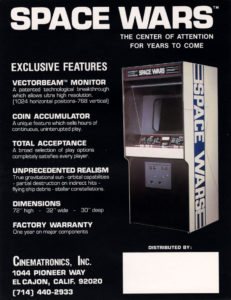 Perhaps the most germane reason for Spacewar’s reemergence on the VCS is the October 1977 Cinematronics arcade game Space Wars. According to historian Keith Smith’s as-yet-unpublished book All in Color for a Quarter, designer Larry Rosenthal’s road to Space Wars is a little twisty. Rosenthal went to MIT in the late 1960s and had seen the original computer game on their PDP computer, though it seems as though it made very little impression on him. Some years later after moving to northern California for his Masters, he came across Computer Space while visiting home on winter break and spotted the cabinet in the MIT student lounge; while he wasn’t particularly interested in playing it, it did begin to get him thinking about the process of engineering a game. After finishing his degree and while deciding what to do next, Rosenthal decided to try and build his own Spacewar game, using his own custom-built computer; a 16-button hex keypad allowed him to program this device and a standard cassette tape deck let him save the program. He soon learned that standard television technology wasn’t suitable for drawing the screen as quickly as he wanted, but since a vector monitor, which would work, would be prohibitively expensive, he ended up tearing apart a commercial black-and-white television to effectively recreate it into a vector display – the end result meant he’d essentially built his own computer hardware, display hardware and written his own game code practically on a whim. His game completed in late 1976, Rosenthal decided to location-test the game at Pinball Palace in Berkeley, California, where it was a huge hit; he soon took to shopping it around to several arcade manufacturers before Cinematronics agreed to sell it, giving Rosenthal a nice 5% royalty and letting him keep the game rights. version included a variety of gameplay options imitating popular ones from the 60s and 70s, such letting players adjust the game speed, the strength of gravity, and whether or not the star is a black hole that will still drag in the ships, but not actually destroy them on contact. Space Wars was the big arcade hit prior to 1978’s Space Invaders, selling in excess of 7,000 units, and was named RePlay magazine’s number one coin-op game in its annual operator survey published in the November 1978 issue. With Cinematronics struggling to keep up with demand, Atari ended up selling a raster-based clone of Space Wars itself under the name Orbit, with developer Owen Rubin telling Smith that he had a matter of weeks to slam the game together.
Perhaps the most germane reason for Spacewar’s reemergence on the VCS is the October 1977 Cinematronics arcade game Space Wars. According to historian Keith Smith’s as-yet-unpublished book All in Color for a Quarter, designer Larry Rosenthal’s road to Space Wars is a little twisty. Rosenthal went to MIT in the late 1960s and had seen the original computer game on their PDP computer, though it seems as though it made very little impression on him. Some years later after moving to northern California for his Masters, he came across Computer Space while visiting home on winter break and spotted the cabinet in the MIT student lounge; while he wasn’t particularly interested in playing it, it did begin to get him thinking about the process of engineering a game. After finishing his degree and while deciding what to do next, Rosenthal decided to try and build his own Spacewar game, using his own custom-built computer; a 16-button hex keypad allowed him to program this device and a standard cassette tape deck let him save the program. He soon learned that standard television technology wasn’t suitable for drawing the screen as quickly as he wanted, but since a vector monitor, which would work, would be prohibitively expensive, he ended up tearing apart a commercial black-and-white television to effectively recreate it into a vector display – the end result meant he’d essentially built his own computer hardware, display hardware and written his own game code practically on a whim. His game completed in late 1976, Rosenthal decided to location-test the game at Pinball Palace in Berkeley, California, where it was a huge hit; he soon took to shopping it around to several arcade manufacturers before Cinematronics agreed to sell it, giving Rosenthal a nice 5% royalty and letting him keep the game rights. version included a variety of gameplay options imitating popular ones from the 60s and 70s, such letting players adjust the game speed, the strength of gravity, and whether or not the star is a black hole that will still drag in the ships, but not actually destroy them on contact. Space Wars was the big arcade hit prior to 1978’s Space Invaders, selling in excess of 7,000 units, and was named RePlay magazine’s number one coin-op game in its annual operator survey published in the November 1978 issue. With Cinematronics struggling to keep up with demand, Atari ended up selling a raster-based clone of Space Wars itself under the name Orbit, with developer Owen Rubin telling Smith that he had a matter of weeks to slam the game together.
Regardless on if Shepherd was inspired by either of the then-recent arcade machines or the computer original, Space War for the VCS a decent rendition of the game. All the major components are there: two ships, limited fuel and ammo, a hyperspace function more in line with a cloaking device than the random movement of Russell’s original version of the game, and a number of option combinations echoing the game’s arcade and computer variants.
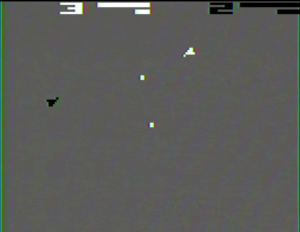 Through the seven “Space War” gametypes, players can decide whether or not to have boundaries along the playfield border or to be able to wrap around the edges. They also get to decide whether or not there is a star pulling you into the center of the screen, a starbase where you can resupply your ship, or nothing at all. Gametypes without a starbase give you no option to refuel, though since you only use fuel when thrusting or when hyperspace is active, it’s possible to build some momentum and then just make adjustments as needed. If both players run out of missiles in gametypes without a starbase, the game will automatically reload eight more. The first player to 10 points within 10 minutes wins the game.
Through the seven “Space War” gametypes, players can decide whether or not to have boundaries along the playfield border or to be able to wrap around the edges. They also get to decide whether or not there is a star pulling you into the center of the screen, a starbase where you can resupply your ship, or nothing at all. Gametypes without a starbase give you no option to refuel, though since you only use fuel when thrusting or when hyperspace is active, it’s possible to build some momentum and then just make adjustments as needed. If both players run out of missiles in gametypes without a starbase, the game will automatically reload eight more. The first player to 10 points within 10 minutes wins the game.
While these options result in a passable version of Spacewar, they also dumb it down enough to lose a lot of the strategy to it. At its core, Spacewar is a game about momentum, velocity and gravity, and how best to use limited resources to destroy your opponent’s ship. There is a degree of strategy and skill to successfully navigating the overwhelming gravity to your advantage in the most popular PDP versions of the game. When the star’s gravity field is either negligible or nonexistent, as it is in the VCS version, it becomes little more than a game of lining up your shot first and being quicker on the trigger. You still have the limited supplies of the computer game, but with the pace of the Atari game and the regular missile restocks it’s less of a concern.
But maybe that’s the point. Atari’s Space War wasn’t being made to appeal to university students and engineers like the computer game was – the VCS was targeting all types of households and players, particularly children. It’s entirely plausible that Shepherd wanted to simplify and speed up the game enough for more people to enjoy it. The manual already has diagrams on how to maneuver around the playfield, so the company certainly wasn’t taking any chances with making an overly complex game this early on in the console’s life.
Those diagrams actually are helpful guides for the second array of gametypes, known as “Space Shuttle.” In these gametypes, one or two players score a point when successfully connecting with a module floating through space. The other gametype options from the Space War games are still available here, notably whether or not there’s a boundary and a sun. Two player games have an additional option of whether or not both players are trying to connect with the same module or have their own color coded ones. Successfully connecting with the module will affect its trajectory and speed to a degree, so it’s entirely possible to get it moving so fast that you can’t easily catch it again – particularly if you flipped the difficulty switch, which requires the player to match speed and angles with the module. Thankfully, these game modes have unlimited fuel. Like the space war variants, you have 10 minutes to be the first player to get 10 points. In practice, the shuttle games are kind of frustrating and wear out their welcome pretty quickly.
As down as I seem to be on Space War, it compares pretty well to contemporary space combat console games. The Channel F’s own Space War game, written by Jerry Lawson, gives each ship a limited amount of energy that runs out as you either fire your laser or get shot by your opponent, though you can always return to the starbase to reenergize. On the flip side, you also only get destroyed upon running out of energy entirely and can’t fire back once you’ve lost a certain amount, so it’s not always wise to get too far from the base. It’s like a bizarre cross between Spacewar and Tank, especially given the lack of momentum, gravity, and asteroids that act as barriers. Moonship Battle on the RCA Studio II has the free movement of both Space War games, though much like the Channel F title, it also lacks any kind of gravity or momentum. Again, you have a limited amount of energy that is depleted as you get shot, fire your missiles, or get hit, though in this case you have no option to recharge. Developer Andy Modla said that he had not seen Spacewar prior to developing his game Moonship Battle; instead it was (very loosely) inspired by the popular 1970s Star Trek computer game. As his first game on the Studio II, he wanted to try and make an action game to get a feel for the system’s limitations and capabilities. It was generally considered by his coworkers – and Andy himself – to be a bit lackluster a project, but ended up shipping in the fall of 1977 as RCA looked for more games to get into production. Jumping ahead a few years, the Vectrex game console also played host to a port of Cinematronics Space Wars arcade game complete with an absolutely vicious computer opponent, though it suffers from the same gravity-and-speed issues as Atari’s version.
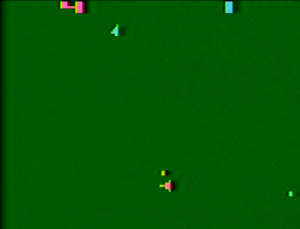 Despite being the first VCS game I’m writing about from 1978, Space War – like the rest of Atari’s catalogue for 1978 – was published for the Christmas season in North America. At the time the video game industry was incredibly cyclical, with new product typically coming out for the holiday shopping season and then vanishing until the next year. Fairchild actually broke this paradigm first with the Channel F – due to the increased production costs the company had to contend with to get FCC approval, it pioneered the razor-and-razorblades model, where new games are sold throughout the year to make up for the thin profit margins (if any) on the hardware itself. Atari would not follow suit with this year-round sales approach until 1979, when Ray Kassar took over the CEO position. Nevertheless, Space War was initially announced at the January CES show as Starship II, though started referring to it as Space War by April during a press showing of it and six other new games. Newspaper advertising suggests Space War didn’t hit store shelves until around October that year alongside the rest of Atari’s new games. Sears did advertise its own Space Combat version of the game in its August catalog without any indication that the game was “coming soon,” but it’s unclear if these were for preorders or if the game was actually available in-store by that point.
Despite being the first VCS game I’m writing about from 1978, Space War – like the rest of Atari’s catalogue for 1978 – was published for the Christmas season in North America. At the time the video game industry was incredibly cyclical, with new product typically coming out for the holiday shopping season and then vanishing until the next year. Fairchild actually broke this paradigm first with the Channel F – due to the increased production costs the company had to contend with to get FCC approval, it pioneered the razor-and-razorblades model, where new games are sold throughout the year to make up for the thin profit margins (if any) on the hardware itself. Atari would not follow suit with this year-round sales approach until 1979, when Ray Kassar took over the CEO position. Nevertheless, Space War was initially announced at the January CES show as Starship II, though started referring to it as Space War by April during a press showing of it and six other new games. Newspaper advertising suggests Space War didn’t hit store shelves until around October that year alongside the rest of Atari’s new games. Sears did advertise its own Space Combat version of the game in its August catalog without any indication that the game was “coming soon,” but it’s unclear if these were for preorders or if the game was actually available in-store by that point.
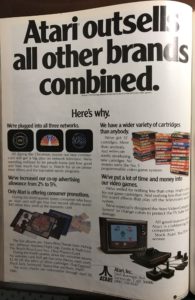
Space War itself did not seem to be one of the company’s bigger releases. By the following fall it was one of the games Atari made eligible for a discount coupon that registered Atari VCS owners would receive, alongside other fairly minor releases like Flag Capture, Blackjack, Surround and Basic Math. The game would be discontinued at the end of 1980, but surprisingly appears to have been rereleased early in 1982. Space War got one small burst of new sales in 1987, when Atari Corp sold 672 copies, but it seems the market for the title had left long before then. Xenia Gazette columnist Dick Cowan wrote briefly about Space War (under the name Space Battles) in a December 1978 edition of the paper alongside another cartridge mysteriously called War Games. He calls the games, thrilling but difficult to control, with enough complexity that it could take a player weeks to gain mastery. “Controlling the speed of movement and ricochet gun firing is an art requiring patience and practice.”
Spacewar’s influence extends beyond the VCS game and its contemporaries, however. Atari’s incredibly successful arcade release Asteroids was designed off the way players move around in the older computer game. Toys For Bob essentially pulled directly from Spacewar for the combat in Star Control and Star Control 2, enhancing it with different kinds of ships with different stats and abilities. Even today, Spacewar is a hidden game on Steam in a form pretty similar to its original one. Tournaments for the game have been held as recently as 2017 at Seattle’s Living Computer museum, and it being readily available using online emulators – and through FPGA recreations of the PDP-1 – has made it incredibly accessible. It’s not much of a stretch to say that nearly every competitive video game has some roots that extend all the way back in 1962 and that weird little computer game, even if Atari’s VCS version is little more than a footnote in its history.
Sources:
Worldly Wednesday: A Timeline of Spacewar, Alex Smith, March 17 2021
Worldly Wednesdays: Nolan Bushnell and Spacewar, Alex Smith March 31 2021
The Origin of Spacewar, Martin Graetz, August 1981
Andy Modla, interviews with the author, October 2017 & June 18 2021
All in Color for a Quarter, Keith Smith, unpublished manuscript
They Create Worlds, Alex Smith, 43-59, 2019
Atari History Timelines, Michael Current
Inside Spacewar, Norbert Landsteiner
The Jerry Lawson Papers, Strong Museum of Play
The Spacewar Reunion, 2018, Smithsonian Museum of American History
Xenia Gazette, December 1 1978
Release Date Sources:
Spacewar! (PDP-1), April 28 1962: The Tech (student newspaper), April 25 1962
Space War (Atari VCS), October 1978: Janesville Gazette, October 12 1978; Blytheville Courier News, October 18 1978
Space War (Channel F), April 1977: Weekly Television Digest, January 17 1977;Los Angeles Times, April 9 1977; Palm Beach Post, April 15 1977
Gunfighter/Moonship Battle (RCA Studio II): RCA press release November 15, 1977; Hutchinson News, November 21 1977; Galveston Daily News, September 6 1977
